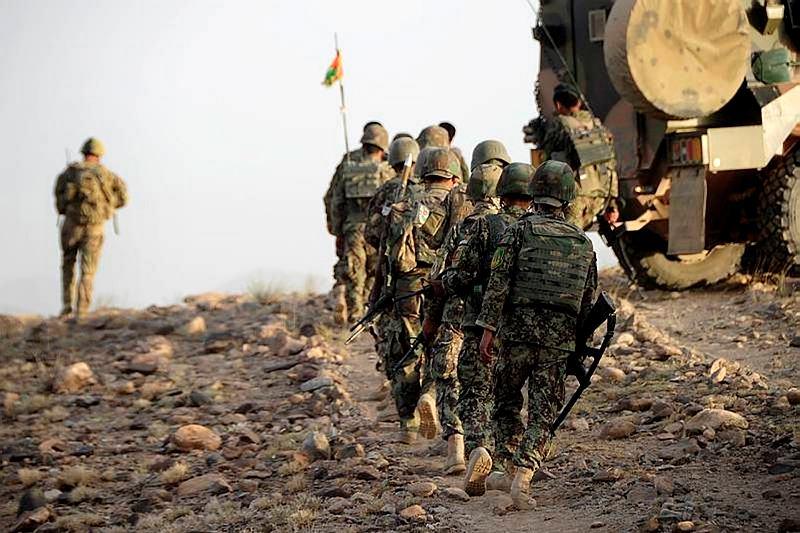Back(wards) to the future: the Australian Army after Afghanistan
Posted By Mitchell Yates on March 5, 2015 @ 12:50
 [1]
[1]December 2014 saw the Australian Army wind down its longest ever warlike commitment—after 13 years of continuous operations, Australian troops ceased combat operations in Afghanistan. Now for the first time in over a decade the Army’s principal focus isn’t a major deployment but developing itself to meet uncertain future threats and maintaining the skills and experience gained in Afghanistan. As the Australian Army becomes a peacetime army again, where to from here?
After a period of post-Cold War stagnation in the 90s, the Army realised that it needed to modernise—and quickly—if it was to remain a credible land force. For over a decade the Army has been in a constant state of transition; ‘Plan Beersheba [2]’ is the latest iteration of a force modernisation program restructuring the Army into a more robust and modern force with some increased scope for amphibious operations [3]. As outgoing Chief of the Army Lieutenant General David Morrison puts it [4], reform is about ensuring the service remains ‘robust and relevant into the future’.
And therein lies the difficulty. Who knows what shape land warfare will take in the future, but must the Army be ‘robust’ enough to confront any hypothetical future conflict? In 1989 when the Iron Curtain came tumbling down, the NATO armies—trained and equipped to fight the vast Soviet armoured forces—could never have predicted that in a few years they’d be neck deep in humanitarian operations in Somalia or peacekeeping (or peacemaking?) in the Balkans.
Historically speaking, the nature of warfare is fluid and constantly shifting, and the major challenge facing an army today is how to maintain its capabilities in order to be credible against a range of threats. This challenge is compounded greatly for small armies, like Australia’s, with modest budgets and personnel and logistical limitations. In a climate of tight budgets [5], the Australian Army cannot afford to be ‘robust and relevant’ across the full range of threats. The Army must pick its role and stick to it—and to be blunt, it should stick to low-intensity warfare.
Why? The Australian Army is very good at conducting low-intensity operations—counterinsurgency, peacekeeping and ‘military operations other than war’—the quintessential small wars. The Army has spent the last 60 years fighting only small wars or counterinsurgencies in Malaya, Borneo, Vietnam, Timor-Leste, Afghanistan and Iraq, and from these conflicts, it has gained immeasurable experience in the conduct of low-intensity warfare. Land Warfare Doctrine 1, Army’s philosophical guidance [6], notes that even though the Army has taken part in major wars, its ‘central theme’ has always been ‘patrolling, ambushing and minor infantry tactics’—fighting skills better suited to lower-intensity operations rather than modern high-intensity manoeuvre warfare. The Army even has a 36 page-long reading list [7] dedicated exclusively to counterinsurgency literature. These are strong indicators of the importance the Army places on low-intensity warfare.
While the Army can support small commitments to lower-intensity conflict zones (13 years in Afghanistan proved that), its logistical base is too limited to supply and support a modern force under higher-intensity conditions for any great period of time. Also, it’s worth mentioning that Australia as a nation may have difficulty absorbing the casualties associated with modern high-intensity combat. The number of Australian personnel killed in action in Afghanistan (41, all from the Army) was used frequently to justify calls from within [8] and outside [9] parliament for a withdrawal from that conflict.
Current Army force modernisation will not abandon the Army’s ability to engage in low-intensity conflict but will shift [10] the service’s focus towards higher-intensity operations. Programs like Land 400—the replacement [11] of the Army’s entire fleet of wheeled and tracked fighting vehicles—are intended to enhance Army’s ability to defeat a ‘near peer [12]’ enemy. But what nation that Australia will ever realistically face alone can meet the definition of near peer?
The Army has spent 60 years fighting insurgents, and that’s unlikely to change any time soon. Whilst conventional high-intensity wars remain possible but improbable, the number of low-intensity conflicts around the globe only seem to be increasing. There have been suggestions [10] that an Australian Army equipped to fight a near-peer enemy should be able to ‘overmatch’ an insurgent enemy, but I don’t buy into that. The US Army that went into the 2003 Iraq War was equipped to fight a near peer enemy—and easily defeated Iraq’s conventional army—but had immense difficulty in countering the asymmetric tactics used by Iraqi insurgents after Saddam’s toppling.
Without clear vision (and doctrine), the Army can easily distract itself from what it does best. Low-intensity may be unglamorous and dirty but it’s the type of conflict the Australian Army is most experienced at, and therefore best suited to, fighting. As James Brown once argued [13], the service’s leadership needs to have a good look at ‘what kind of fighting the Australian Army will need to do in the next decade… with a budget-limited force structure’.
As the Australian Army moves forwards into an uncertain future, it should cast an eye on its past, looking backwards and drawing on its deep past experience in low-intensity warfare to help shape its future role and structure.
Mitchell Yates is a postgraduate doctoral research student at the University of Western Sydney. Image courtesy of Department of Defence [14].
Article printed from The Strategist: https://aspistrategist.ru
URL to article: /backwards-to-the-future-the-australian-army-after-afghanistan/
URLs in this post:
[1] Image: https://aspistrategist.ru/wp-content/uploads/2015/03/20110728adf8114832_056.jpg
[2] Plan Beersheba: http://www.army.gov.au/Our-future/Projects/Plan-BEERSHEBA
[3] amphibious operations: https://aspistrategist.ru/australia-and-amphibious-power/
[4] puts it: http://www.defence.gov.au/defencemagazine/issue/3/articles/27.html
[5] tight budgets: https://aspistrategist.ru/the-2014-defence-budget-as-good-as-it-gets/
[6] philosophical guidance: http://www.army.gov.au/Our-future/Publications/Key-Publications/Land-Warfare-Doctrine-1
[7] reading list: http://www.army.gov.au/Our-future/Publications/Research-Papers/Working-Papers/WP135
[8] within: http://greensmps.org.au/content/news-stories/time-bring-our-troops-safely-home-afghanistan
[9] outside: http://www.news.com.au/national/reasons-to-bring-the-troops-home/story-fndo4eg9-1226500782352
[10] shift: https://aspistrategist.ru/land-400-equipping-australias-army/
[11] replacement: http://www.army.gov.au/Our-future/Projects/Project-LAND-400
[12] near peer: http://www.defence.gov.au/media/speechtpl.cfm?CurrentId=11167
[13] argued: http://www.lowyinstitute.org/publications/challenge-innovation-australian-army
[14] Department of Defence: http://images.defence.gov.au/20110728adf8114832_056.jpg
Click here to print.